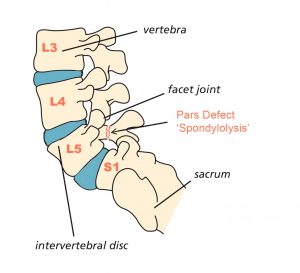What is a pars defect?
The ‘pars’ is a small length of bone that joins the facet joints of one vertebra to the facet joints of the vertebra below it. There is a pars interarticularis on each side of the vertebrae at the back of the spine.
A pars defect is a small break or fracture in the bone that connects the facet joints and they can become separated. About 80% of pars defects occur on both sides of the vertebra (bilateral) however they can also happen on only one side (unilateral).
More than 85% of pars defects are found in the L5 vertebrae, with about 10% occurring in the L4 and to much lesser in the L3 and L2 vertebrae.

If your symptoms persist after conservative management or are severe, a pars injection maybe considered for both treatment and diagnostic purposes. Mr Hilton performs all pars injections in theatre under X-ray guidance. You may choose whether you want it under local anaesthetic or sedation.
The pars defect or stress fracture is injected with local anaesthetic and a steroid. The local anaesthetic should reduce pain in the for 4 – 6 hours and therefore can be used to confirm, or exclude, whether the pain is originating from the pars defect.
The steroid part of the injection reduces the inflammation in the surrounding area which can reduce pain and other symptoms caused by inflammation such as nerve irritation.
One Question That Is Always Asked: How Long Will It Last?
The answer is, everyone is different; for some people the pain relief from a nerve root injection can last many months or years but for others, the benefit may only last a a few weeks or even a few hours.
If the benefit is only short-lived (even just for a few hours) or you gain no benefit at all at anytime, it maybe very disappointing but do not worry; it has not failed because it has been very useful diagnostically to help confirm if the pain is coming from the pars defect. This is essential when surgery is being considered.
After you have had the procedure, it is very helpful if you can keep a note as to how your symptoms change especially in the first few hours after the injection and over the next few days.
Questions To Ask Yourself Are:
1) Has the procedure taken my back pain away? For example, has it taken 100%, 75% or 50% of the pain away? Or, how much of of the pain is left?
2) If you have leg pain as well, does it take the pain away?
3) Does your mobility or walking distances improve?
4) If you also have reduced sensation or pins and needles, does the injection help these symptoms?
5) What symptoms are still left?
Bring your answers with you to your follow-up appointment.
How are pars defect injections performed?
Like all spinal injections, Mr Hilton performs pars defect injections under X-ray guidance to guarantee the injection is in exactly the right place. Patients are taken into the operating suite; some elect to have the procedure under sedation and other choose to have it under local anaesthetic. Either way, patients have the procedure lying on their front on the operating table.
The image intensifier (a special X-ray machine) is used to guide a special needle into the affected pars and then a special dye is injected to confirm the correct position on the X-ray before the local anaesthetic and steroid is injected into the pars defect.
Recovery
Immediately following the procedure, patients spend some time within the recovery area of theatres where they are monitored. Following this, they are able to be discharged home.
Patients who have had sedation will be unable to drive home and should not drive the following day. Patients are able to mobilize as comfortable but should take the following day off work. Patients should only experience minor pain following the procedure. Physiotherapy and exercise should be started as soon as possible following the procedure.


